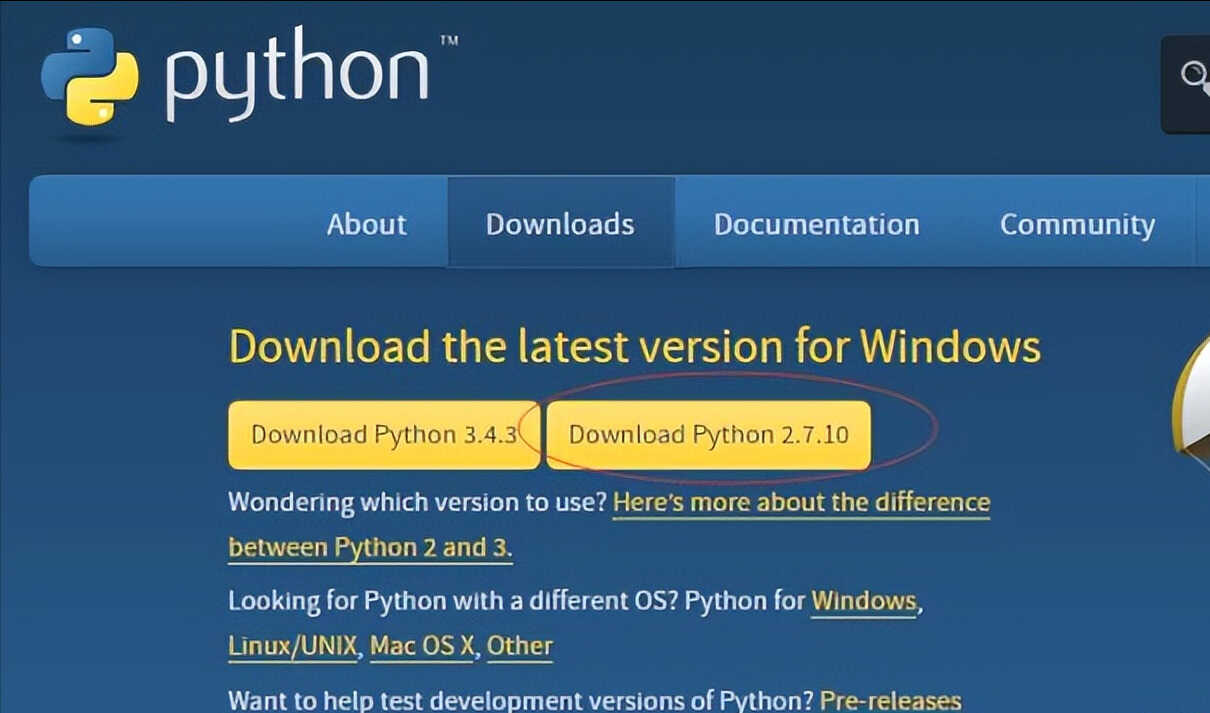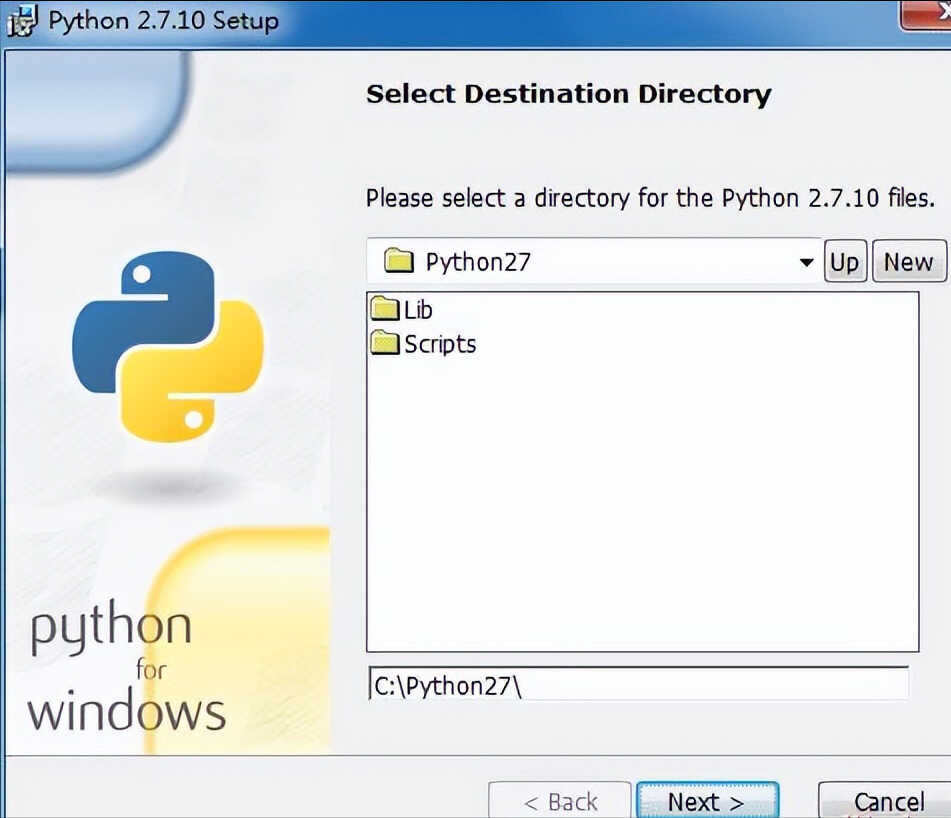Python安装(win7)
在本教程中,我使用的是 python2.7 版本,打开官方网站的下载页面,如下所示:

下载完成后,双击 python-2.7.10.msi 这个二进制文件并安装,指定安装路径。
第一步:双击 python-2.7.10.msi 安装

第二步:选择安装路径

第三步:将 Python 程序添加到“系统环境变量”
第四步:安装完成!
第五步:测试安装结果,点击“开始”,选择" Python(command line)"
到此,Python 的所有设备安装完成!接下来我们就可以编写测试 Python 程序了。
第一个Python程序
交互式模式编程:
调用解释不通过一个脚本文件作为参数,就可以调出以下提示(Linux平台下):
root# python
Python 2.5 (r25:51908, Nov 6 2007, 16:54:01)
[GCC 4.1.2 20070925 (Red Hat 4.1.2-27)] on linux2
Type "help", "copyright", "credits" or "license" for more info.
>>>
在 Python 提示符的右侧输入下列文本并按下回车键:
>>> print "Hello, Python!";
这将产生以下结果:
Hello, Python!
Python标识符
Python标识符是一个用来标识变量,函数,类,模块,或其他对象的名称。标识符是以字母A到Z或a〜z开始后面跟零个或多个字母下划线(_),下划线和数字(0〜9)。
Python不允许标点字符标识符,如@,$和%。Python是一种区分大小写的编程语言。 比如 Manpower 和 manpower 在Python中是两种不同的标识符。
下面是在Python标识符的命名约定:
- 类名称以大写字母为主,其他的标识符以小写字母为主。
- 单个前导下划线开始的标识符表示该标识符意味着约定是私有的。
- 开始是两个前导下划线的标识符表示强烈专用标识符。
- 如果标识符还具有两个尾随下划线结束时,所述标识符是语言定义的特殊名称。
保留字
下面的列表显示的是在Python的保留字。这些保留字不可以用作常量或变量或任何其它标识符名称。
行和缩进
一个程序员在学习Python时,遇到的第一个注意事项是,Python中不使用括号来表示代码类/函数定义块或流量控制。 代码块由行缩进,这是严格执行表示。
缩进位数量是可变的,但是在块中的所有语句必须缩进量相同。在这个例子中,两个块都很好(没有问题):
if True:
print "True"
else:
print "False"
然而,在这个例子中,第二块将产生一个错误:
if True:
print "Answer"
print "True"
else:
print "Answer"
print "False"
多行语句
在Python语句通常有一个新行表示结束。Python里面,但是,允许使用续行字符(\)表示该行应该继续。例如:
total = item_one + \
item_two + \
item_three
包含在语句[], {}, 或()括号内不能使用续行字符。例如:
days = ['Monday', 'Tuesday', 'Wednesday',
'Thursday', 'Friday']
在Python中的引号
Python的接受单引号('),双引号(“)和三('''或”“”)引用来表示字符串,只要是同一类型的引号的开始和结束的字符串。
三重引号可以用来横跨多行字符串。例如,下面所有的表示都是合法的:
word = 'word'
sentence = "This is a sentence."
paragraph = """This is a paragraph. It is
made up of multiple lines and sentences."""
在Python中的注释
哈希符号(#)不是一个字符串字母开头,它是一个注释的开始。#之后以及到物理行结束的所有字符都是注释的一部分,Python解释器会忽略它们。
#!/usr/bin/python
# First comment
print "Hello, Python!"; # second comment
这将产生以下结果:
Hello, Python!
注释在一个语句或表达式后的同一行:
name = "Madisetti" # This is again comment
可以注释多行,如下所示:
# This is a comment.# This is a comment, too.# This is a comment, too.# I said that already.
使用空行
仅包含空格,可能带有注释行,被称为一个空行,Python完全忽略它。
在交互式解释器会话,必须输入一个空的物理线路终止多行语句。
在一行上的多个语句
分号(;)允许在单一行上编写多条语句,语句开始一个新的代码块。下面是使用分号示例片断:
import sys; x = 'foo'; sys.stdout.write(x + '\n')
多组语句称为套件
组成一个单一的代码块个别语句组在Python中被称为套件。
组件或复杂的语句,如if,while,def和类,是那些需要一个标题行和套件。
标题行开始语句(用关键字),并终止并显示冒号(:),接着是一行或多行,组成套件。
例子:
if expression :
suiteelif expression :
suite
else :
suite
Python - 变量类型
变量是什么,不是是保留在内存位置用来存储一些值。这意味着,当创建一个变量,它会在内存中保留一些空间。
根据一个变量的数据类型,解释器分配内存,并决定什么样的数据可以存储在保留存储器。 因此,通过分配不同的数据类型的变量,可以存储整数,小数或字符在这些变量中。
给变量赋值
在=操作符的左侧是变量名,在=运算符的右边是存储在变量中的值。例如:
counter = 100 # An integer assignment
miles = 1000.0 # A floating point
name = "John" # A string
print counter
print miles
print name
标准数据类型
Python有五个标准数据类型:
- 数字
- 字符串
- 列表
- 元组
- 字典
Python的数字
当分配一个值给创建的 Number 对象。例如:
var1 = 1var2 = 10
Python支持四种不同的数值类型:
- int (有符号整数)
- long (长整数[也可以以八进制和十六进制表示])
- float (浮点实数值)
- complex (复数)
这里是数字的一些例子:
Python字符串
Python的字符串在引号之间确定为一组连续的字符。
例子:
str = 'Hello World!'
print str # Prints complete string
print str[0] # Prints first character of the string
print str[2:5] # Prints characters starting from 3rd to 6th
print str[2:] # Prints string starting from 3rd character
print str * 2 # Prints string two times
print str + "TEST" # Prints concatenated string
Python 列表
列表是最通用的 Python 复合数据类型。列表包含在方括号 ([]) 内用逗号分隔,包含的各种数据类型的项目。
#!/usr/bin/python
list = [ 'abcd', 786 , 2.23, 'john', 70.2 ]
tinylist = [123, 'john']
print list # Prints complete list
print list[0] # Prints first element of the list
print list[1:3] # Prints elements starting from 2nd to 4th
print list[2:] # Prints elements starting from 3rd element
print tinylist * 2 # Prints list two times
print list + tinylist # Prints concatenated lists
Python 元组
元组是类似于另一列表序列的数据类型。元组中由数个逗号分隔每一个值。 不像列表,元组中括号括起来。
元组可以被认为是只读的列表。
tuple = ( 'abcd', 786 , 2.23, 'john', 70.2 )
tinytuple = (123, 'john')
print tuple # Prints complete list
print tuple[0] # Prints first element of the list
print tuple[1:3] # Prints elements starting from 2nd to 4th
print tuple[2:] # Prints elements starting from 3rd element
print tinytuple * 2 # Prints list two times
print tuple + tinytuple # Prints concatenated lists
Python字典
Python的字典是哈希表类型。它们运作就像关联数组或类似在Perl中的哈希,由键值对组成。
tinydict = {'name': 'john','code':6734, 'dept': 'sales'}
print dict['one'] # Prints value for 'one' key
print dict[2] # Prints value for 2 key
print tinydict # Prints complete dictionary
print tinydict.keys() # Prints all the keys
print tinydict.values() # Prints all the values








